List of Items on Display at the Rare Book & Manuscript Library
Who was Aesop?
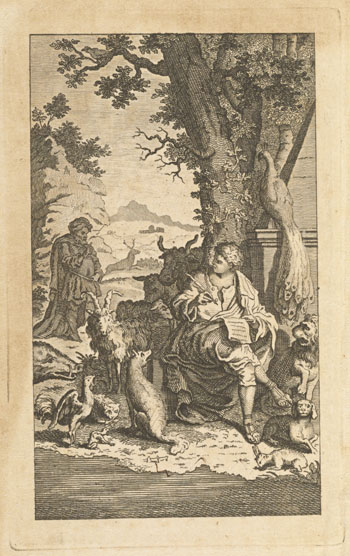
Samuel Croxall. Fables of Aesop and Others.
(London: 1760).
1.1 Samuel Croxall. Fables of Aesop and Others: translated into English, with instructive applications, and a print before each fable. Illustrated by Elisha Kirkall. 7th edition. London: J. and R. Tonson, 1760.
The historical Aesop is elusive, though the oldest sources agree he was a slave and won his freedom "by his wits." The Fables of Aesop by Reverend Samuel Croxall (1688-1752) first appeared in 1722 with a preface that relates the life of the "great Aesop" from "the good old authors" like Phaedrus and Aristotle. Phaedrus wrote, "The Athenians set up a statue in honor of the gifted Aesop, and by so doing placed a slave on a pedestal of everlasting fame."
Croxall's collection was printed in small format editions that dominated Aesop in English for nearly two centuries. On this title page, a scribe listens to Aesop parlay with a sheep.
1.2 Fabulae variorum auctorum. Frankfurt: Christ. Gerlach & Sim. Beckenstein, 1660.
Fables are old—scholars have even found them on Mesopotamian clay tablets. Similarly, versions of the life of the historical Aesop have circulated since 400 BCE.
In the Life of Aesop, composed around 1300 CE by the Byzantine scholar Maximus Planudes, a legendary Aesop wanders the world. Planudes' Life of Aesop was translated and printed throughout Europe as an introduction to the fables.
In Planudes' Life, Aesop is accused of filching figs. In order to prove his innocence, as this 1660 German edition illustrates, he vomits. The servants who accused him were then forced to vomit and the figs came up, demonstrating Aesop's innocence, his presence of mind, and his readiness to vomit on his master.
1.3 Aesopi phrygis fabellae Graece & Latine, cum alijs opusculis. Basel: Johann Froben, 1524.
Aesop’s Fables were among the first books to appear as printing spread across Europe. William Caxton published the first English editions in 1484 and 1497.
In 1518 Johann Froben published his Aesopi Phrygis vita et fabellae, with a life of Aesop and a selection of 192 fables. The book was published as an elementary text for students moving from Latin to Greek. For the next three centuries reprints rapidly proliferated, especially in university towns, such as Oxford and Cambridge.
On display, the fable “The Eagle and the Fox” is printed in both Greek and Latin. The University of Illinois Library has both the 1518 edition and the 1524 reprint.
Other Fabulists

Francis Barlow. Æesop's Fables. (London: 1687).
2.1 Phaedrus. Liberti Fabularum Aesopiarum, Libri V. Edited and annotated by David Hoogstratan. Amsterdam: Francis Halm, 1701.
Phaedrus (early first century CE) was a fabulist (creator of fables or legends) who wrote in Latin verse, many of which were based on Aesop. About 120 survive. His poems are often the oldest known versions of fables, including several in which Aesop is a character. He adapted from Aesop and other sources, and invented fables of his own. Many of his fables, such as “The Cock and the Pearl” and “The Monkey King,” are frequently attributed to Aesop.
The edition on display shows a form of illustration common in the eighteenth century, where one page provides small illustrations for several following fables. It illustrates “Aesop and His Master,” “The Wolf and Lamb,” “The Frogs Praying for a King,” “The Raven with Borrowed Plumage,” “The Dog and His Reflection,” and “The Lion’s Share.”
2.2 Babrius. Mythologia Aesopica, In qua Aesopi Fabulae Graecolatine CCXCVII. Frankfurt: Nicolai Hoffmann, 1610.
Babrius (late first century CE) wrote fables in Greek verse. Slightly more than 140 of his fables survive intact or in paraphrase. In this work, Babrius presents different versions of fables also told by Phaedrus, as well as many of his own.
In “The Lion and Bulls,” a lion decides that attacking three bulls in a group would be risky, so “with crafty words and slander” he separates them, then kills them one by one. The fables of Babrius, as with those of Phaedrus, are now often retold under Aesop’s name.
2.3 Vishnusharman. Pañchatantra. Translated by Arthur W. Ryder. Illustrated by Y. G. Srimati. New York: The Limited Editions Club, 1972.
The Pañchatantra (“Five Books”) is a fable collection written in Sanskrit, perhaps as early as the third century BCE. A king, troubled by his three unruly sons, asked Vishnusharman to educate them. Vishnusharman composed this collection of animal fables, and fables within fables within fables, which succeeded in teaching them the worldly wisdom they needed to rule and survive.
The Pañchatantra is often called Machiavellian, but it also shares an Aesopica view. In “How the Birds Picked a King,” the birds nearly choose an owl, but a crow dissuades them by telling two fables, thereby creating perpetual enmity between crows and owls.
Wise Animals: More Fabulists
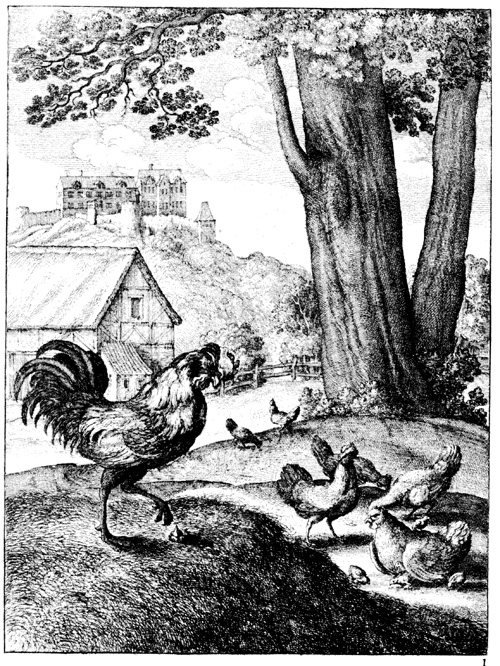
John Ogilby. The Fables of Aesop Paraphras'd
in Verse. (London: 1668).
3.1 The Instructive and Entertaining Fables of Pilpay, containing a number of excellent rules for the conduct of persons of all ages. London: S. Birt, 1747.
Ibn al-Muqaffa’ (8th century CE) converted the Pañchatantra into the Arabic Kalīlah wa-Dimnah, a collection of fables used to comment on the politics of the Abbasid empire. He was murdered on orders of the Caliph soon after.
Kalīlah wa-Dimnah was translated into Greek around 1080 CE, and was soon known in Europe as the work of “Pilpay” or the “Arabic Aesop.”
Pilpay was said to be “universally read” in the East and Aesop himself was said to have been “an oriental.”
3.2 Jean de La Fontaine. The Fables. Translated into English verse by Walter Thornbury, with illustrations by Gustave Doré. London and New York: Cassell, Petter, and Galpin, 1873.
The most celebrated reteller of Aesop is Jean de La Fontaine(1621-1695), many of whose fables were based on the Aesop corpus. Recast in exquisite French verse for King Louis XIV and his court, La Fontaine's versions appeared in five books, published between 1664 and 1682.
Gustave Doré illustrated an 1867 edition of La Fontaine's Fables that was widely translated and remains in print. The lion in the fable on display fell in love with a beautiful maiden, whose clever father agreed to the marriage only if the lion consented to have his teeth and claws removed to avoid harming the bride. The lovesick lion agreed, and the father subsequently killed the defenseless lion.
3.3 John Gay. Fables. 2 volumes. London: John Stockdale, 1793.
The most renowned of English fabulists is John Gay (1685-1732), best known for The Beggar's Opera (1728). Gay published books of fables in 1727 and 1738. They went through many printings.
In "The Tame Stag," a deer becomes caught in a thicket and is captured. The Lord's wife begs for the deer's life. The deer is then tamed and becomes a nuisance to the household.
This edition of Gay's Fables was illustrated by a number of engravers, including William Blake (1757-1827) who engraved the illustration on display. It was published by John Stockdale, whose edition of Aesop's Fables, also published in 1793, is shown in an adjoining case.
Aesop for Adults

Roger L'Estrange. Fables, of Aesop and other
Eminent Mythologists. (London: 1692).
4.1 John Ogilby. The Fables of Aesop Paraphras'd in Verse, Adorn'd with Sculpture, and Illustrated with Annotations. 2nd edition. London: Printed by Thomas Roycroft, for the Author, 1668.
The first English translations and adaptations of "Aesopica," or collections of fables originating from many sources and varying according to the publication, were dedicated to rich and powerful patrons. They were often published in large formats that only the well-to-do could afford.
The sumptuous printing of "this first and most antient mythologist Aesop" in two volumes (1665 and 1668) by John Ogilby (1600-1676) begins with "The Cock and the Jewel," often the first fable in Aesop collections.
A rooster finds a jewel but tosses it aside, as it is of no use to him. Ogilby's moral is that fools cannot discern value. L'Estrange's version, however, moralizes that gems are frivolous luxuries of no use to sensible creatures.
4.2 Roger L'Estrange. Fables, of Aesop and other Eminent Mythologists: with Morals and Reflexions. London: R. Sare, T. Sawbridge, B. Took, M. Gillyflower, A. & J. Churchil, and J. Hindmarsh, 1692.
Roger L'Estrange (1616-1704) is perhaps better known for his writings in support of the Royalists, opposing John Milton in the mid-century pamphlet wars with his publication No Blinde Guides.
His edition of Fables (1692) is huge—a folio with 500 fables. It was also hugely influential, with his own morals, a Life of Aesop, and fables added from Avianus, Abstemious, Poggio, and others, whose fables now often appear under Aesop's name.
His image of Aesop—hunchbacked and pot-bellied, and a writer in the midst of animals—is based on the description in Maximus Planudes' Life of Aesop (item 1.2).
4.3 John Stockdale. The Fables of Aesop, with a Life of the Author. 2 volumes. London: John Stockdale, 1793.
John Stockdale (1750-1814) published verses based on Aesop in an expensive edition accessible only to wealthy buyers.
"The Lion and the Lamb," on display, was retained in almost all editions of Stockdale's Fables.
In it, a wolf offers a series of reasons he is entitled to eat the lamb, but the lamb refutes them all. At last, tired of arguing, the wolf eats the lamb anyway.
The moral: "Wherever ill people are in power, innocence and integrity are sure to be persecuted."
Aesop for Children
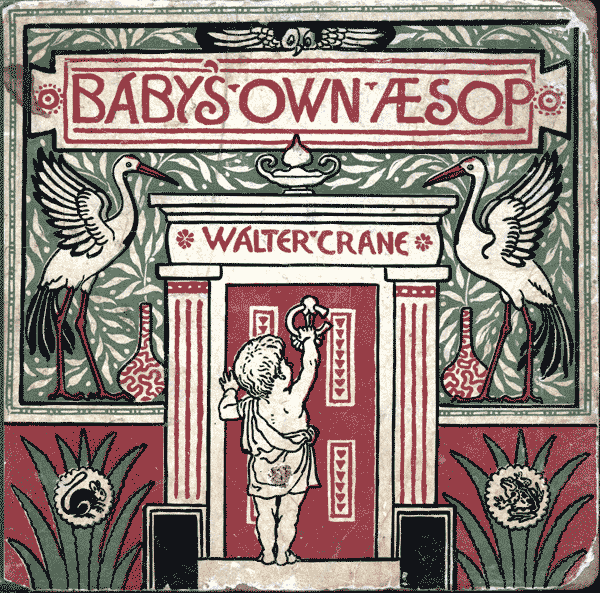
Walter Crane. The Baby's Own Æsop.
(London, New York: G. 1887).
5.1 Aesop's Fables. London: Booker and Dolman, et al., 1838.
This illustrated duodecimo Aesop is one of many editions produced in small formats especially for children.
This Aesop is an abridgement of Croxall's collection (item 1.1) and shows on its title page a different interpretation of Aesop's likeness. Aesop is still portrayed as a writer, but here Aesop is depicted as a handsome old man, no longer the pot-bellied hunchback seen in the L'Estrange version (see item 4.2).
From the collection of Willis Goth Regier
5.2 Mary Godolphin. Aesop's Fables in Words of One Syllable. London: Cassell, Petter, and Galpin, 1868.
The notion that Aesop's fables were for children has seldom been more shrewdly advanced than by the historian Lucy Aikin (1781-1864), who reduced them to a level accessible to first-year readers.
The "Fox and Crow" depicts successful flattery: the Fox praises the Crow's beauty and asks whether its voice is also beautiful. The Crow opens its mouth to sing (as if it could), dropping its food, which the Fox takes and runs off with.
Aikin also repackaged Robinson Crusoe, The Pilgrim's Progress, and The Swiss Family Robinson into words of one-syllable, all published posthumously under the pseudonym Mary Godolphin.
5.3 Walter Crane. The Baby's Own Æsop: Being the Fables Condensed in Rhyme, with portable morals pictorially pointed. London, New York: G. Routledge & Sons, 1887.
Children's books attract great illustrators, among them Walter Crane (1845-1915), whose illustrations dominate the text, here reduced to limericks. Crane's books were read to pieces by children, making surviving first editions in fine condition rarities coveted by collectors.
In addition to Aesop, Crane illustrated Cinderella's Picture Book, Grimm's Fairy Tales, and Nathaniel Hawthorne's Wonder Book and Tanglewood Tales, all in the collection of the University of Illinois Library.
5.4 Milo Winter. The Aesop for Children. Chicago: Rand McNally & Co., 1919.
Milo Winter (1888-1956), born in Princeton, Illinois, was trained at the Art Institute of Chicago and lived and worked in Chicago for most of his career.
His The Aesop for Children has been regularly reprinted. Winter also illustrated The Arabian Nights, Alice in Wonderland, Twenty Thousand Leagues Under the Sea, The Three Musketeers, Gulliver's Travels, and The Illustrated Bible Story Books, Old and New Testaments.
Perhaps the best known of Aesop's fables is "The Hare and the Tortoise," in which diligent competence wins and lazy talent loses.
Illustrating Aesop
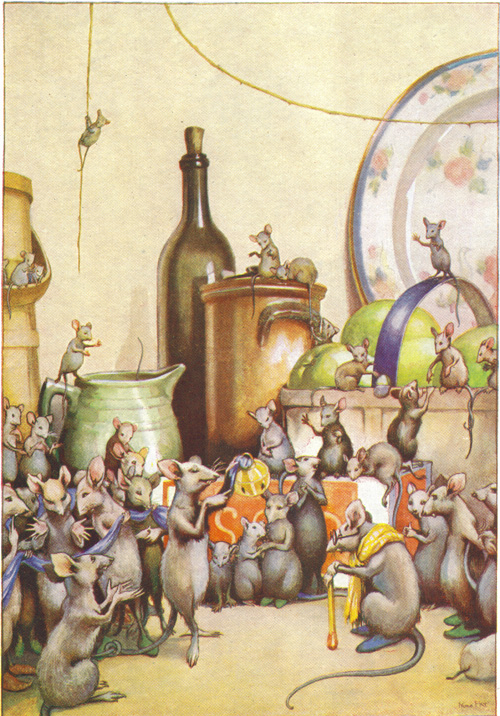
Aesop's Fables. Illustrated by Nora Fry.
London: J. Coker & Co., Ltd., 1929.
6.1 Francis Barlow. Aesop's Fables, With His Life, in English, French, and Latin. Illustrated with one hundred and twelve sculptures. To this edition are likewise added, thirty one new figures representing his life. London: H. Hills, Jr. for Francis Barlow, 1687.
After Ogilby (see item 4.1), the next great Aesop was illustrated by Francis Barlow (1626?-1704), whose depictions of Aesop emphasized his hunchback and belly. The illustration on display accompanies another well known fable: a lion spares a mouse, and in turn the mouse saves the lion, chewing a net to set him free.
Barlow originally published this work in 1666, but most of the print run was lost in the Great London Fire of the same year. The University of Illinois owns a rare copy of the 1666 edition as well as the 1687 second edition, which includes a new illustrated Life of Aesop with poetic captions by Aphra Behn (1640?-1689), one of England's earliest women writers.
6.2 J. B. Rundell. Aesop's Fables, with text based chiefly upon Croxall, La Fontaine, and L'Estrange. Illustrated by Ernest Griset. London: Cassell, Petter, Galpin, 1869.
Ernest Griset (1844-1907) drew animals from life at the London Zoo and made a career as an illustrator for books and periodicals. On display, he illustrates one of two contrasting fables.
In "The Lion's Share," a greedy lion consents to share the proceeds of a hunt with other animals, but when the hunt is done he takes almost everything. But the mighty, too, get old. In "The Old Lion," a fable from Phaedrus, an old lion lies helpless, despised, and injured by those he once terrified.
From the collection of Willis Goth Regier
6.3 Aesop's Fables: A New Translation by V. S. Vernon Jones. Illustrated by Arthur Rackham. London: William Heinemann, 1912.
Many great illustrators drew and painted Aesop's fables in the early twentieth century. One of the most popular is Arthur Rackham (1867-1939), whose illustrations adorn innumerable reprints.
"The Quack Frog" illustrates a frog who claimed to cure all ailments. He is exposed by a fox who questions his medical expertise since he looks so sick himself.
The fable is often included among collections of Aesop's fables but was first introduced by Aphthonius in the fourth century CE.
Illustrating Aesop in the Twentieth Century

The Fables of Aesop. Illustrated by Edward J. Detmold.
London: Hodder and Stoughton, 1909.
7.1 Aesop's Fables. Illustrated by J. M. Condé. New York: The Platt & Peck Co., 1913.
The "Mice in Council," or "Who Will Bell the Cat?" is another fable written by someone else that frequently appears in collections attributed to Aesop. It was written by Odo of Cheriton, a thirteenth-century cleric.
The familiar fable illustrates how courage fails when action is needed to get the better of a tyrant or bully. It is a favorite fable for illustrators. For this edition of Aesop's Fables, Condé followed the style of the times, dressing his mice to add color and decorum. Condé also illustrated other popular children's books including Albert Bigelow Paine's Hollow Tree Series and Joel Chandler Harris' collections of Uncle Remus tales.
From the collection of Willis Goth Regier
7.2 Aesop's Fables. Illustrated by Nora Fry. London: J. Coker & Co., Ltd., 1929.
Nora Fry's depiction of the "Mice in Council" fable not only pays close attention to what mice actually look like (only one has a shawl and glasses), but also goes beyond the fable's simple facts to satirize the assembly. Typical features of a public gathering can be seen in the faces of the crowd: many listen, but many others are distracted, and some pay no attention at all.
Fry's illustrations have stayed in print since the first edition of 1929. Though she illustrated several other children's books, this is her most enduring work.
From the collection of Willis Goth Regier
7.3 The Fables of Aesop. Illustrated by Edward J. Detmold. London: Hodder and Stoughton, 1909.
Edward Detmold (1883-1957) was the twin brother of Maurice Detmold (1883-1908) and both won praise for their paintings of birds and other animals.
While still in their teens, they exhibited at the Royal Institute of Painters. In 1903 they illustrated an edition of Kipling's The Jungle Book. In 1905, both were elected associates of the Royal Society of Painter–Etchers and Engravers.
Edward Detmold's illustration of "The Hare and the Tortoise" shows both the quality of his work in watercolor and his wit: where is the tortoise?
Aesop at Illinois
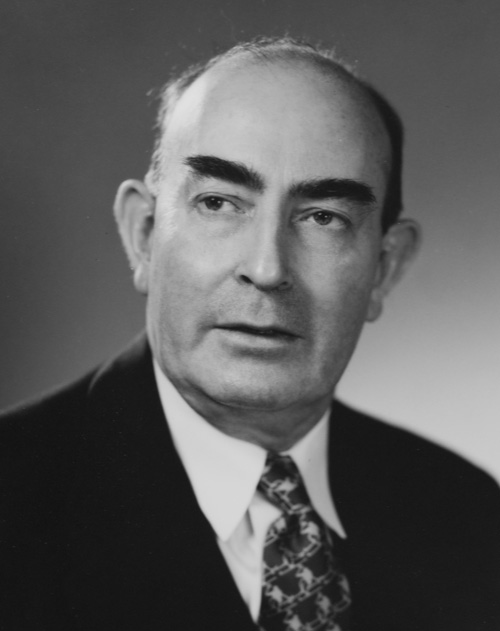
Benjamin Perry. Photo courtesy of the
University of Illinois Archives
8.1 Benjamin Perry. Studies in the Text History of the Life and Fables of Aesop. Haverford, Pennsylvania: American Philological Association, 1936.
One of the world's greatest scholars of Aesop and Aesopica was Benjamin Perry (1892-1968), who taught at the University of Illinois from 1924 to 1960.
This, his first extensive study of Aesopica, builds on previously published essays and established Perry as an internationally recognized expert. He spent much of the next two decades preparing his masterwork, the 1952 Aesopica.
From the collection of Willis Goth Regier
8.2 Benjamin Perry. Aesopica: A Series of Texts Relating to Aesop or ascribed to him or closely connected with the literary tradition that bears his name; collected and critically edited, in part translated from Oriental languages, with a commentary and historical essay. Urbana, Ill.: University of Illinois Press, 2007.
Perry's monumental Aesopica, including two versions of the Life of Aesop, was published by the University of Illinois Press in 1952(reprinted in 2007).
The American Journal of Philology affirmed that "it is safe to say that all future study of the Aesopic tradition will rest on this vast collection." It is the basis for Lloyd W. Daly's translation Aesop without Morals (Yoseloff, 1961) and Laura Gibb's Aesop's Fables (Oxford, 2002).
From the collection of Willis Goth Regier
8.3 Babrius and Phaedrus. Cambridge, Mass.: Harvard University Press, 1965.
Perry edited, introduced, and annotated the Loeb edition of Babrius and Phaedrus, published by Harvard University Press in 1965.
From the collection of Willis Goth Regier
8.4 Photo of Benjamin Perry
Photo courtesy of the University of Illinois Archives

